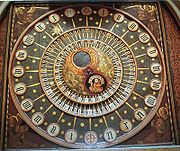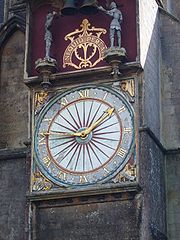
Wells Cathedral clock
Encyclopedia

Astronomical clock
An astronomical clock is a clock with special mechanisms and dials to display astronomical information, such as the relative positions of the sun, moon, zodiacal constellations, and sometimes major planets.-Definition:...
in the north transept
Transept
For the periodical go to The Transept.A transept is a transverse section, of any building, which lies across the main body of the building. In Christian churches, a transept is an area set crosswise to the nave in a cruciform building in Romanesque and Gothic Christian church architecture...
of Wells Cathedral
Wells Cathedral
Wells Cathedral is a Church of England cathedral in Wells, Somerset, England. It is the seat of the Bishop of Bath and Wells, who lives at the adjacent Bishop's Palace....
, England.
The clock is one of the group of famous 14th to 16th century astronomical clocks to be found in the West of England.
The surviving mechanism, dated to between 1386 and 1392, was replaced in the 19th century, and was eventually moved to the Science Museum
Science Museum (London)
The Science Museum is one of the three major museums on Exhibition Road, South Kensington, London in the Royal Borough of Kensington and Chelsea. It is part of the National Museum of Science and Industry. The museum is a major London tourist attraction....
in London, where it continues to operate. The dial represents the geocentric view of the universe, with sun and moon revolving round a central fixed earth. It may be unique in showing a philosophical model of the pre-Copernican
Copernican Revolution
The Copernican Revolution refers to the paradigm shift away from the Ptolemaic model of the heavens, which postulated the Earth at the center of the galaxy, towards the heliocentric model with the Sun at the center of our Solar System...
universe.
Another dial is mounted on the outside wall, driven from the same mechanism. This was first installed in the 14th or 15th centuries, but has been restored a number of times.
Description

In the corners, four angels hold the four cardinal winds. These may be generating the power that makes the universe operate.
The minutes are indicated by a smaller star on the ring inside.
The inner circle shows the moon. A pointer indicates the age of the moon, between 1 and 30 days. The black and white disk above the centre shows the moon's phase. The white disk rotates once in a synodic month. The inscription around the moon phase indicator says sphericus archetypum globus hic monstrat microcosmum, which translates as This spherical globe here shows the archetypal microcosm. Howgrave-Graham suggests that the scribe erroneously put microcosmum, when macrocosmum is the more obvious word. Opposite the moon circle is a weighted pivoted disc, containing a small painting of Phoebe
Phoebe (mythology)
In Greek mythology "radiant" Phoebe , was one of the original Titans, who were one set of sons and daughters of Uranus and Gaia. She was traditionally associated with the moon , as in Michael Drayton's Endimion and Phœbe, , the first extended treatment of the Endymion myth in English...
, representing the moon. The inscription reads: Sic peragrat Phobe, or So progresses Phoebe.
At the centre of the dial, the ball represents the earth, and the clouds suggest the same.
Above the clock and to the right is a figure, known as Jack Blandifers, who hits bells with a hammer held in his right hand and by hitting his heels on two bells hung beneath him. A set of jousting knights also chase each other every 15 minutes.
History
There are mentions of a clock at Wells during the first half of the 14th century, with a payment being made for the keeper of the clock in 1392-1393.In 1388, Bishop Ralph Erghum moved from Salisbury to Wells. He had previously been Bishop of Salisbury
Bishop of Salisbury
The Bishop of Salisbury is the ordinary of the Church of England's Diocese of Salisbury in the Province of Canterbury.The diocese covers much of the counties of Wiltshire and Dorset...
, from 1375 to 1388, and had installed a clock there
Salisbury cathedral clock
The Salisbury Cathedral clock, a large iron-framed clock without a dial located in the aisle of Salisbury Cathedral. Supposedly dating from about 1386, it is claimed to be the oldest working clock in the world....
in 1386. He may have brought his clockmakers with him to Wells. The two clocks are almost identical in construction, although the Wells clock shows some improvements and additions, which suggests that some valuable lessons had been learned. The Wells striking system uses a double lever, for example, which is more reliable than the system used in Salisbury. It can be safely assumed that the Wells clock and the Salisbury clock are roughly of the same age, as they share a lot of construction details. The assumption that both clocks were made in the 14th century is not verifiable, as only a payment to a keeper of a clock is mentioned, but no detail about the clock itself at the time is known.
The clock was converted to pendulum
Pendulum
A pendulum is a weight suspended from a pivot so that it can swing freely. When a pendulum is displaced from its resting equilibrium position, it is subject to a restoring force due to gravity that will accelerate it back toward the equilibrium position...
and anchor escapement
Anchor escapement
In horology, the recoil or anchor escapement is a type of escapement used in pendulum clocks. An escapement is the mechanism in a mechanical clock that maintains the swing of the pendulum and allows the clock's wheels to advance a fixed amount with each swing, moving the hands forward...
in the 17th century. It was installed in the Science Museum in 1884.
In August 2010, the current Keeper of the Great Clock of Wells, Paul Fisher, announced his retirement. With the Cathedral authorities planning to fit an electric motor to wind the clock, his retirement will end the practice of winding the clock by hand.
Further reading
- R P Howgrave-Graham, New light on ancient turret clocks Antiquarian Horology, 1954.
See also
- Salisbury cathedral clockSalisbury cathedral clockThe Salisbury Cathedral clock, a large iron-framed clock without a dial located in the aisle of Salisbury Cathedral. Supposedly dating from about 1386, it is claimed to be the oldest working clock in the world....
- Exeter Cathedral#Clock,
- Ottery St Mary#The church
- Wimborne Minster

